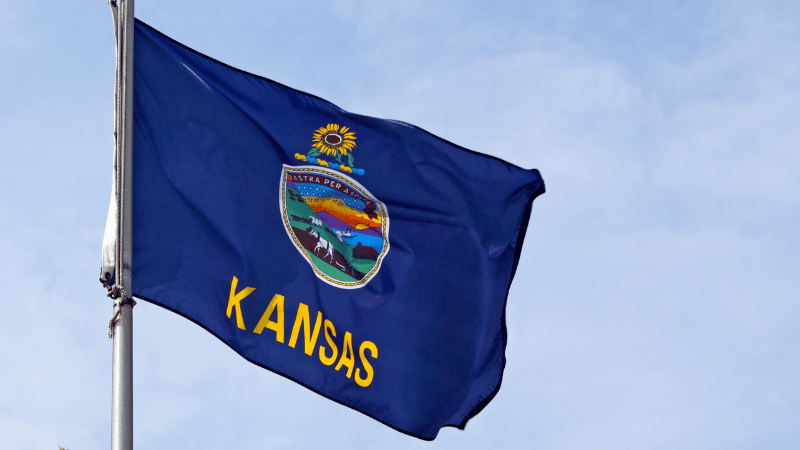There are currently over 18,000 nonprofits in Kansas. From healthcare facilities to educational organizations and beyond, these nonprofits provide necessary services to those in need. Starting a nonprofit in Kansas is a multi-step process, but this guide will help you join the ranks of the many nonprofits in Kansas making a difference.
Steps to Start a Nonprofit in Kansas

We hope you’re excited to launch your nonprofit in Kansas! Some steps can feel complicated, but this guide will help you navigate through any roadblocks. As you work through this process, follow along with our checklist for starting a nonprofit organization.
Step 1: Name Your Organization
A name can inspire your audience, tell a story, and excite the public. The right name will help you raise awareness and important funds for your cause. Kansas corporations must include one of the following words or abbreviations in their name:
- Association
- Church
- College
- Company
- Corporation
- Club
- Foundation
- Fund
- Incorporated
- Institute
- Society
- Union
- University
- Syndicate
- Limited
- Co.
- Corp.
- Inc.
- Ltd.
You can choose any name that shares your organization’s mission as long as it includes one of these words or abbreviations. When you’re ready, search the Secretary of Kansas website to also make sure it’s available!
If you’re having trouble deciding on a name for your nonprofit, we’ve created a naming checklist to help.
Step 2: Choose Your Mission
After deciding on a name, the next essential item on the list is your nonprofit’s mission. The Internal Revenue Service (IRS) requires 501(c)(3) nonprofit organizations to benefit the public with one of the following purposes:
- Charitable
- Religious
- Educational
- Scientific
- Literary
- Testing for Public Safety
- Fostering national or international amateur sports competitions
- Preventing cruelty to children and animals
With this purpose, you have a focus, and now it’s time to create a unique mission statement for your nonprofit that fits this purpose.
Since your nonprofit’s purpose statement must be the same on all state and federal applications, choosing a mission statement will make the process easier. A mission statement also influences an organization’s marketing and culture. As you move to the next step – creating a business plan – keep your mission statement in mind.
Step 3: Create a Business Plan
You can use your nonprofit business plan to:
- Establish your organization’s goals
- Understand your beneficiaries and donors
- Assess the feasibility of your fundraising model
- Solicit funders
- Attract board members and volunteers
Having a robust business plan in place before continuing with the process of starting a nonprofit in Kansas will make filing necessary state and federal paperwork easier. It will also help you find critical startup funds!
Programs and Services
The first section of your nonprofit business plan will lay out the organization’s programs and services. How will you fulfill your mission? What makes you different from other organizations with the same purpose? Answering these questions will have a significant impact on funders. Remember, people’s attention spans are limited, so it’s best to include images and infographics when explaining complicated ideas.
Marketing Plan
Your programs and services are critical, but you must also know who your target market is. Your marketing plan is where you should provide details on two types of markets: donors and beneficiaries.
You’ll need information on their demographics, interests, and giving ability. Your marketing plan should include communication plans for potential donors, foundations, partners, etc.
Operational Plan
The next section will help you create your organization’s bylaws, which are required when applying for tax exemption with the IRS. Your operational plan should include day-to-day activities, necessary legal requirements, and any insurance you may need. An organizational chart will help you provide details on the roles and responsibilities of your nonprofit board and staff.
Pro tip: If you have an organizational chart, you can include it in the appendix to help illustrate how your organization operates. Learn more about the six types of nonprofit organizational charts and see them in action in this free e-book.
Impact Plan
The effect your nonprofit has on your community is its greatest appeal to funders. In the beginning, your organization’s impact is entirely in your mind. It’s vital to spend time on this section of your business plan and elaborate on how your organization can reach its goals.
Financial Plan
Typically, business plan financials will include bank statements and reports. Since you don’t have any yet, you’ll need to research your competitors. Visit GuideStar and research similar nonprofits’ tax documents for examples of revenues and expenses. This information will give you a solid foundation for your organization’s budgets.
Executive Summary
An Executive Summary is the first thing the funders read, but it should be the last thing you write. This section gives an overview of your business plan and describes your organization’s mission, target market, and how you’ll meet the needs of your community.
Appendix
This section provides a space for additional documentation you may need, including:
- IRS determination letter
- Board member resumes
- Marketing pieces
Step 4: Choose an Incorporator and Board of Directors
An Incorporator will sign your nonprofit’s Articles of Incorporation. Kansas nonprofits must have one incorporator but can have more. Kansas nonprofits must also have a minimum of one director. If you plan to apply for tax exemption with the IRS, they require at least three directors. Your nonprofit may need more than this, however, to run your organization and fundraise efficiently.
Kansas has no residency requirement for board members. Board directors must be naturalized people and hold their offices until they are replaced. The state also requires nonprofits to have a minimum of one officer to prepare minutes for directors’ and members’ meetings and keep financial records. The same individual can hold two or more board officer positions.
Step 5: Appoint a Registered Agent
Your nonprofit’s registered agent is responsible for receiving legal notices for your organization. Your registered agent must be located in the state and open during regular business hours.
Step 6: File Articles of Incorporation

Kansas nonprofits must file articles of incorporation using Form A1 and pay a $20 fee. If you file online, you will receive an immediate response. However, if you file by mail, it may take up to four business days unless you pay an additional $20 expedited fee.
To apply for tax-exempt status with the IRS, these articles must also state your organization’s public purpose and include a no-distribution statement.
Step 7: Get Your Employer Identification Number
After filing your articles of incorporation, you must file for an employer identification number with the Internal Revenue Service (IRS). You can file Form SS-4 immediately online or by mail. Corporations will receive a certificate of acknowledgment from the secretary of state’s office.
Step 8: Hold Your First Board Meeting
Before filing for tax exemption, you must hold your nonprofit’s first board meeting. This board meeting is an opportunity to elect your officers, assign board members to committees, and start onboarding and training.
During this first meeting, you should also finalize and adopt the organization’s bylaws and conflict of interest policy, as well as approve opening a bank account.
Bylaws
Your nonprofit bylaws will be a roadmap for your board of directors. Nonprofit bylaws must include the following:
- Name and purpose of your organization
- Officer roles, terms, election details
- Board meeting guidelines, including frequency and quorum
- Board structure, including size and committees
- Membership program details
- Compensation and indemnification of board members
Conflict of Interest Policy
The IRS does not allow any board or staff member to benefit financially from an exempt nonprofit’s earnings. Your organization’s conflict of interest policy will provide rules to follow when individuals in leadership have conflicting priorities.
Step 9: Apply for 501(c) Status
Nonprofits that benefit the public can apply with the IRS as 501(c)(3) organizations and file either Form 1023-EZ or Form 1023. Organizations that earn under $50,000 for the first three years can file Form 1023-EZ for $275. There is an eligibility worksheet to determine if your organization qualifies. All other 501(c)(3) nonprofits must file Form 1023 and pay $600. It can take up to six months to receive your determination letter from the IRS.
Nonprofits that primarily benefit their members may also qualify for some benefits from the IRS. These organizations must use Form 1024 and pay $600 to become 501(c)(4) organizations with the IRS.
Step 10: File for State Tax Exemption
Charities that have gained tax exemption from the IRS are automatically exempt from paying state taxes in Kansas but may be responsible for paying property and other local taxes. Be sure to contact your local city or county for more information.
Religious organizations are automatically exempt without filing with the IRS, but many choose to file to earn the trust and loyalty of their congregations.
Step 11: File with the Department of Labor
If your nonprofit plans to hire employees, you must create an account with the Kansas Department of Labor to apply for state unemployment tax.
Step 12: Register to Solicit Donations
Kansas nonprofits must also register with the Attorney General’s office before soliciting donations unless they are considered exempt.
Step 13: Business Licenses and Permits
Kansas requires nonprofits to file for permits and licenses in certain areas. Visit this website to see if any apply. You must also apply for a license with the Kansas Department of Revenue to hold a charitable raffle, bingo, or lottery game.
Step 14: File an Annual Report
Kansas nonprofits must file annual reports with the Secretary of State by the 15th day of the sixth month following the close of the nonprofit’s taxable year.
Nonprofits can also use annual reports to build trust with donors and solicit gifts from foundations. You can share your organization’s annual report on your website, social media platforms, and third-party websites like GuideStar.
Conclusion
Starting a nonprofit in Kansas is a journey filled with purpose and potential. Following these steps can lay a solid foundation to fulfill your organization’s mission and make a meaningful difference in your community. Remember, your nonprofit’s impact extends far beyond its formation. Donorbox offers a host of tips and resources to help you build a strong board, attract and manage volunteers, and raise funds.
Visit our website to see how Donorbox can help raise funds for your new nonprofit.
Sign up for access to weekly fundraising tips and resources. Best of luck on your nonprofit adventure!






